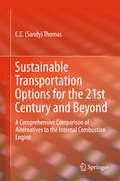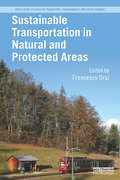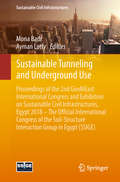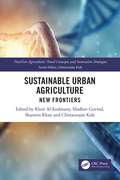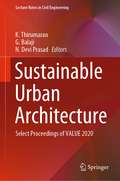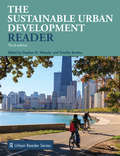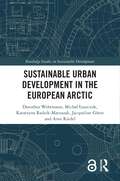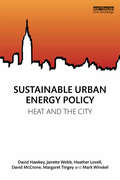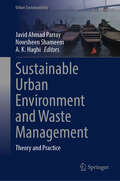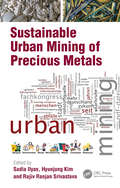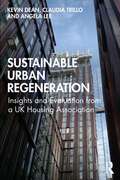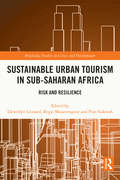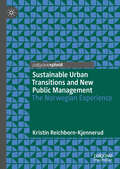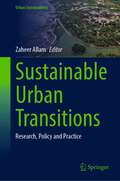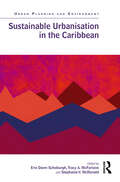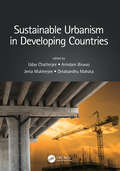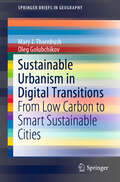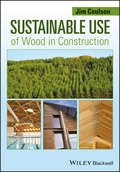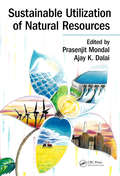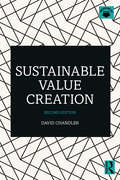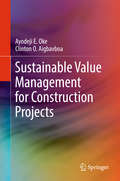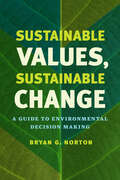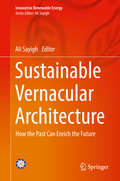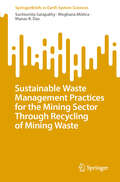- Table View
- List View
Sustainable Transportation Options for the 21st Century and Beyond
by C. E. Sandy ThomasThis book includes an in-depth analysis of the environmental and energy security impacts of replacing the internal combustion engine vehicle with various forms of electric vehicles and replacing gasoline and diesel fuel with alternative fuels including electricity, hydrogen and biofuels. In addition to a detailed "well-to-wheels" analysis of local air pollution, greenhouse gas emissions and oil consumption for each alternative vehicle, the book estimates the market penetration potential of each fuel/vehicle combination to determine the most likely societal impact of each alternative vehicle pathway. To support the market penetration estimates, the book analyses the likely cost of each alternative vehicle in mass production and the cost of installing the necessary fuel infrastructure to support each option. The book provides sufficient detail to allow decision makers in governments and industry to choose among the alternative vehicle/fuel combinations that will lead to a truly sustainable transportation system.
Sustainable Transportation in Natural and Protected Areas (Routledge Studies in Transport, Environment and Development)
by Francesco OrsiProtected areas are at the centre of nature-based tourism, which is increasingly popular across the world. As visitor numbers increase, so does awareness of the harmful effects that large crowds may have on both natural resources and individuals’ recreational experience. This volume considers the challenge of transportation to and within natural and protected areas, the improvement of which has already been recognised as having great potential for mitigating the environmental impacts of ecotourism. While several books have focused considerable attention to the management of protected areas in general, little has been said about the specific issue of sustainable transport, an emerging trend that is already reshaping visitation patterns in natural settings. This book provides current knowledge on issues associated with the transportation of visitors in natural and protected areas, and a comprehensive overview of the technical and strategic options available to tackle these issues. It approaches the subject via three main topics: preferences, or the visitors' attitudes towards transportation; practices, where current approaches are assessed through examples and case-studies of successful experiences and methodologies from around the world; and policies, where suggestions and recommendations are put forward for both local scale strategies and broad-scale regulatory action with global relevance. Contributors include academics in the field of natural resource management and tourism, with extensive experience in protected area management and active partnerships with natural park administrations.
Sustainable Tunneling and Underground Use: Proceedings of the 2nd GeoMEast International Congress and Exhibition on Sustainable Civil Infrastructures, Egypt 2018 – The Official International Congress of the Soil-Structure Interaction Group in Egypt (SSIGE) (Sustainable Civil Infrastructures)
by Mona Badr Ayman LotfyThis volume comprises a set of high-quality, refereed papers that address the different aspects related to the geotechnical and structural design and construction of deep excavations, tunnels and underground space facilities as well as the effect of their construction on the surroundings. The papers cover planning, design, modeling, monitoring and construction aspects of these essential structures. The utilization of underground space using tunneling and deep excavations has become much needed to support the increasing needs of urban environments and to allow for functional extensions and sustainable developments in heavily congested areas. Recently, more utilities and transportation transit systems have been relocated underground because of scarcity of surface space. The growing interest in the use of underground space has necessitated commensurate advancements in related fields (geotechnical engineering, engineering geology and structural engineering), design tools, construction techniques and analytical and interpretation methods. The volume is based on the best contributions to the 2nd GeoMEast International Congress and Exhibition on Sustainable Civil Infrastructures, Egypt 2018 – The official international congress of the Soil-Structure Interaction Group in Egypt (SSIGE).
Sustainable Urban Agriculture: New Frontiers (Nextgen Agriculture)
by Chittaranjan Kole Kheir Al-Kodmany Sharmin Khan Madhav GovindIn the vibrant discourse of urbanization and climate change, Sustainable Urban Agriculture: New Frontiers investigates emerging needs, rising challenges, and opportunities to support urban agriculture. Navigating the dynamic interplay of urbanization and environmental challenges, the book introduces two pivotal agendas for urban sustainability—the "green" agenda, focusing on environmental health, and the "brown" agenda, emphasizing human well-being and social justice. The book embraces a global perspective by confronting geographical biases and advocating for context-specific understanding and early interventions in small and medium cities. This transformative journey guides readers through uncharted territories, fostering profound awareness of urban agriculture's role in shaping a sustainable and resilient future in agriculture.Features Presents information on socio-ecological resilience, shaping a sustainable urban future Unveils practical implications, traversing frontiers where urban cultivation extends beyond crops, cultivating a thriving urban ecosystem Discusses diverse urban agriculture practices, from traditional methods to cutting-edge technologies Providing readers with an understanding of the multifaceted layers inherent in urban agriculture, this volume in the NextGen Agriculture: Novel Concepts and Innovative Strategies series is essential for academics, students, practitioners, and experts in urban agriculture and planning, horticulture, landscape architecture, and plant sciences.
Sustainable Urban Architecture: Select Proceedings of VALUE 2020 (Lecture Notes in Civil Engineering #114)
by K. Thirumaran G. Balaji N. Devi PrasadThis book presents select proceedings of the International Conference on Visionary Action towards Liveable Urban Environments (VALUE 2020). Various topics covered in this book include context responsive architecture, green architecture, energy efficient buildings, energy conservation, inclusive spatial environments, security in buildings and cities, green/smart/ intelligent architecture, sustainable mobility and smart communities. This book will be a valuable reference for students, researchers, and professionals interested in built environment and allied fields.
Sustainable Urban Development Reader (Routledge Urban Reader Series)
by Timothy Beatley Stephen M. WheelerBuilding on the success of its second edition, the third edition of the Sustainable Urban Development Reader provides a generous selection of classic and contemporary readings giving a broad introduction to this topic. It begins by tracing the roots of the sustainable development concept in the nineteenth and twentieth centuries, before presenting readings on a number of dimensions of the sustainability concept. Topics covered include land use and urban design, transportation, ecological planning and restoration, energy and materials use, economic development, social and environmental justice, and green architecture and building. All sections have a concise editorial introduction that places the selection in context and suggests further reading. Additional sections cover tools for sustainable development, international sustainable development, visions of sustainable community and case studies from around the world. The book also includes educational exercises for individuals, university classes, or community groups, and an extensive list of recommended readings.The anthology remains unique in presenting a broad array of classic and contemporary readings in this field, each with a concise introduction placing it within the context of this evolving discourse. The Sustainable Urban Development Reader presents an authoritative overview of the field using original sources in a highly readable format for university classes in urban studies, environmental studies, the social sciences, and related fields. It also makes a wide range of sustainable urban planning-related material available to the public in a clear and accessible way, forming an indispensable resource for anyone interested in the future of urban environments.
Sustainable Urban Development in the European Arctic (Routledge Studies in Sustainable Development)
by Dorothea Wehrmann Michał Łuszczuk Katarzyna Radzik-Maruszak Jacqueline Götze Arne RiedelFocusing on cities in the European Arctic, this book consolidates research on sustainable development, local and urban governance, and transnational cooperation in the region. It examines to what extent there is transnational cooperation between urban areas in remote locations and how it can be enhanced to better align with global sustainable development policies to successfully implement goals such as the 2030 Agenda for Sustainable Development and the Paris Climate Agreement. Based on field research in seven cities in the European Arctic, Rovaniemi, Kolari, Nuuk, Akureyri, Tromsø, Kiruna, and Luleå, the authors explain why approaches to sustainable urban development differ between geographies, how policies relate to other local and global strategies, and to what degree the European Arctic is normative for remote regions at large. This book contributes to important conceptual debates on local governance and transnational cooperation by examining the benefits and potential issues of applying theoretical models of multi-actor engagement and participation in isolated populations. It argues that the participation of local actors in decision processes may encourage a better harmonisation of sustainable urban development approaches in the European Arctic and will have a greater impact at the global level if aligned transnationally. This book will be relevant to researchers, social scientists, policymakers, practitioners, and NGOs in the fields of global governance, sustainable development, sustainability research, and environmental studies.The Open Access version of this book, available at http://www.taylorfrancis.com, has been made available under a Creative Commons Attribution-Non Commercial-No Derivatives (CC-BY-NC-ND) 4.0 license.
Sustainable Urban Energy Policy: Heat and the city (Routledge Studies in Energy Policy)
by Mark Winskel Janette Webb David McCrone David Hawkey Heather Lovell Margaret TingeyMinimising the most severe risks of climate change means ending societal dependence on fossil fuels, and radically improving the efficiency with which we use all energy sources. Such deliberate transformative change is, however, without precedent. Sustainable Urban Energy Policy debates the major public issue of developing a sustainable, clean and affordable energy system by adopting a distinctive focus on heating in cities. In this way, the book constructs an original account of clean energy policy, politics and provision, grounded in new empirical data derived from case studies of urban and multi-level governance of sustainable heat and energy saving in the UK and Europe. Offering an original conceptual framework, this study builds on socio-technical studies, economic and urban sociology, human geography, applied economics and policy studies in order to understand energy governance and systemic change in energy provisions. This book is a valuable resource for students and academics in the areas of Science and Technology Studies, Sociology, Geography (Urban Studies) and Political Economy as well as energy policy makers, social housing providers and energy practitioners.
Sustainable Urban Environment and Waste Management: Theory and Practice (Urban Sustainability)
by Javid Ahmad Parray A. K. Haghi Nowsheen ShameemThis very unique research-oriented edited collection introduces waste and pollution treatment methods that can be adopted at local and international levels and examines appropriate resource management strategies for environmentally related issues. It aims to highlight the important role of education for environmental sustainability, in particular the area of urban waste management. Presenting the latest research topics innovative ideas to educate future citizens regarding sustainable development of our planet, it is of interest to readers who are involved in education, policy, science, and technological innovation for urban waste management. Education and awareness in the field of waste management is significantly important from a global perspective of resource management. The aim of this edited collection is creating an interdisciplinary platform for researchers and practitioners to present and discuss the most recent innovations, trends, and concerns as well as practical challenges encountered and solutions adopted in the fields of Environmental Science. This new book explores the crucial nexus between innovative solutions for waste management, and environmental sustainability in an edited collection. This comprehensive book provides a holistic investigation of the most recent inventions, advancements, and breakthroughs in waste management as the need for solutions to the environmental pollution problem becomes more urgent on a global scale. The book investigates the diverse environmental effect of environmental pollution and emphasizes how urgent it is to resolve the ecological costs of waste contamination.
Sustainable Urban Mining of Precious Metals
by Sadia IlyasThe rapid revolution in modern industry has led to a significant increase in waste at the end of the product lifecycle. It is essential to close the loop, secure resources, and join up the circular economy. This book provides a detailed review of extraction techniques for urban mining of precious metals including gold, silver, and the platinum group. The merits and demerits of various extraction methods are highlighted, with possible suggestions for improvements. The feasibility of hybrid extraction techniques, as well as the sustainability and environmental impact of every process, is explored. Offers a comprehensive review of different techniques used in recycling technology for urban mining of precious metals Describes the concept of urban mining and its correlation with circular economy Discusses feasibility of precious metal extraction and urban mines scope and their potential Explains the subject in-context of sustainability while describing chemistry fundamentals and industrial practices Provides technical flow sheets for urban mining of precious metals with diversity of lixiviant This book is aimed at graduate students and researchers in extractive metallurgy, hydrometallurgy, chemical engineering, chemistry, and environmental engineering.
Sustainable Urban Regeneration: Insights and Evaluation from a UK Housing Association
by Angela Lee Kevin Dean Claudia TrilloThis book provides a deep insight into urban regeneration schemes and explores the parameters of what is deemed a sustainable development, before appraising existing schemes’ evaluation models for the sustainable return on investment. The authors present a new practical evaluation tool that suggests quantifiable benefits for all urban regeneration stakeholders. This new method enables the gauging of the full sustainable impact, from a given outlay of money invested in a housing-led urban regeneration scheme, through an evidence-based proof and can be used to: Better fulfil sustainability criteria in terms of all three aspects of the triple bottom line and contribute in a more sustainable way to address the United Nation’s Sustainable Development Goal 11 Reduce financial waste and plug the gap created by the recent economic shortfall which is impacting on housing associations, tenants and communities alike Evaluate historical housing-led urban regeneration schemes and model future schemes. The method can be used as a strategic decision making or management tool, with schemes being able to be planned in, prioritised or carried out in a targeted and strategic manner; and it can be used for modelling purposes, for publicity purposes and alongside existing tools. This book provides a unique method of fully and sustainably evaluating housing-led urban regeneration schemes, useful for planners, strategic management, local authorities, housing associations, the construction industry and built environment students alike.
Sustainable Urban Tourism in Sub-Saharan Africa: Risk and Resilience (Routledge Studies in Cities and Development)
by Pius Siakwah Llewellyn Leonard Regis MusavenganeThis book investigates urban tourism development in Sub-Saharan Africa, highlighting the challenges and risks involved, but also showcasing the potential benefits. Whilst much is written on Africa’s rural environments, little has been written about the tourism potential of the vast natural, cultural and historical resources in the continent’s urban areas. Yet these opportunities also come with considerable environmental, social and political challenges. This book interrogates the interactions between urban risks, tourism and sustainable development in Sub-Saharan African urban spaces. It addresses the underlying issues of governance, power, ownership, collaboration, justice, community empowerment and policies that influence tourism decision-making at local, national and regional levels. Interrogating the intricate relationships between tourism stakeholders, this book ultimately reflects on how urban risk can be mitigated, and how sustainable urban tourism can be harnessed for development. The important insights in this book will be of interest to researchers and practitioners across Tourism, Geography, Urban Development, and African Studies.
Sustainable Urban Transitions and New Public Management: The Norwegian Experience
by Kristin Reichborn-KjennerudNordic welfare states are often looked to by those who favor more collective and collaborative models of governance. However, as in other European countries, in recent decades the New Public Management (NPM) model has hollowed out much of the Nordic welfare state. This book studies Norway, a late adopter of NPM, and demonstrates the consequences of these changes on Norwegian society and its compatibility with the transition to a more sustainable society. The first half of the book demonstrates the ensuing consequences of NPM on Norwegian society, and questions whether NPM is compatible with the transition to a more sustainable society. The second half of the book describes a more transformative direction, furthering sustainable cities that will support the health and wellbeing of their inhabitants better, and ushering more collaborative efforts to improve sustainability. Working from visions of a new future rather than from existing systems, based on an alternative and more holistic governance model, could take our communities in a more sustainable direction. The book will be of great interest to scholars and students of sustainability, public management and urban development.
Sustainable Urban Transitions: Research, Policy and Practice (Urban Sustainability)
by Zaheer AllamThis book aims to explore how sustainability transitions can be explored in current and future cities and how research and policy approaches can be applied to change urban life as we know it, hence aligning the two thematic of urban science and future science, for achieving deep decarbonization. On this, the discourse on philosophy, ethics, and morality appertaining to sustainable cities and urban transitions, across disciplines, are also welcomed as it provides a deeper understanding of humanity in future scenarios. Chapter 08 is available open access under a Creative Commons Attribution 4.0 International License via link.springer.com.
Sustainable Urbanisation in the Caribbean (ISSN)
by Stephanie V. McDonald Dawn Schoburgh, Edited by ErisSustainable Urbanisation in the Caribbean critically examines the socio-geographic context of island states, prioritising the nuanced experiences of Caribbean island states and territories that are largely considered small island developing states (SIDS), against the backdrop of the UN Sustainable Development Goals (SDGs).Increases in urban density place enormous pressure on existing infrastructures and natural resources, exacerbating social inequalities and environmental risks. While the UN SDGs aim to mitigate these risks, the reality of implementing these goals in the context of SIDS is complex. Whereas Sustainable Urbanisation in the Caribbean does not claim to be a comprehensive assessment of policy responses to the SDGs, this edited volume seeks to generate problem-focused, policy-relevant, demand-driven research, thereby permitting the geographical contexts of island states to contribute to the development of proper causal theory about sustainable urbanisation.This book will be of interest to students of public policy, urban sustainability and climate change, as well as government policy analysts, development practitioners, urban planners and UN agencies working in SIDS.
Sustainable Urbanism in Developing Countries
by Arindam Biswas Jenia Mukherjee Uday Chatterjee Dinabandhu MahataThe mushrooming of illegal housing on the periphery of cities is one of the main consequences of rapid urbanisation associated with social and environmental problems in the developing countries. Sustainable Urbanism in Developing Countries discusses the linkage between urbanism and sustainability and how sustainable urbanism can be implemented to overcome the problems of housing and living conditions in urban areas. Through case studies from India, Indonesia, China, etc., using advanced GIS techniques, this book analyses several planning and design criteria to solve the physical, social, and economic problems of urbanisation and refers to urban planning as an effective measure to protect and promote the cultural characteristics of specific locations in these developing countries. FEATURES Investigates an interdisciplinary approach to urbanism, including urban ecology, ecosystem services, sustainable landscapes, and advanced geographical systems Analyses unique case studies of rapid urbanisation from a local to a national scale in countries such as India, Sri Lanka, China, Bangladesh, Malaysia, and Indonesia and their global impact Examines the use of GIS and spatial statistics in analysing urban sprawl and the massive amount of data gathered by every operational activity of municipalities Focuses on the holistic perspective of sustainable urbanism and the harmony in the human–nature relationship to achieve sustainable development Covers a wide range of issues manifested in urban areas with economic, societal, and environmental implications contributed by leading scholars from the Global South
Sustainable Urbanism in Digital Transitions: From Low Carbon to Smart Sustainable Cities (SpringerBriefs in Geography)
by Mary J. Thornbush Oleg GolubchikovThis book examines how contemporary urbanism is influenced by digital and low carbon transitions. From its infancy at the scale of individual buildings, a focus on ‘green’ agenda, energy, and resource efficiency has fostered research and policies for low carbon cities, eco-cities, and increasingly intelligent and smarter urban systems. Cities around the world are getting ‘smarter’ as more advanced technology is integrated into urban planning and design. People are relying more on digital and information and communication technology (ICT) in their daily lives, while cities are adopting more digital technology to monitor and gather information about people and their environment. This leads to Big Data collection, which is used to inform governance and improve urban performance. These transformations, however, raise critical questions, including whether emerging smart sustainable cities are too technocratic, but also with regard to citizen involvement. This brief addresses these important contemporary concerns through a review of literature and existing urban strategies. It should be of interest to everyone involved in advancing sustainable cities and smart cities. It should also be a relevant read for students and researchers in this area.
Sustainable Use of Wood in Construction
by Jim CoulsonThere is a great deal of innovation in the use of wood in construction, from impressive modern buildings to new construction products that reduce build times and improve building performance. As a renewable resource with proven low embodied energy, wood is both an environmentally responsible and a highly practical choice as a construction material. However, forest management practices vary throughout the world: some are highly effective in delivering a sustainable, long term supply of timber; whereas others are less so, and could result in forest depletion and significant environmental degradation. Against this background, a number of certification schemes have been developed that seek to ensure that all timber is harvested from sources that are at least legally-sourced, and at best, sustainably managed. Sustainable Use of Wood in Construction explains how and why wood may be grown sustainably, and how this versatile material can be specified and - most importantly - sourced, for use in the construction industry. It explains the modern regulatory framework within Europe that seeks to eliminate the use of illegally-harvested wood, and it shows how to ensure that everyone who sells or uses wood for construction is following the rules. Finally, the book explains how, at the end of its first use in construction, wood can be recycled, by reprocessing into another wood-based construction material, or by using it as biomass. Also available Wood in Construction: How to avoid costly mistakes Jim Coulson Paperback, 978 0 4706 5777 Structural Timber Design to Eurocode 5 Second Edition Jack Porteous & Abdy Kermani Paperback, 978 0 4706 7500 7
Sustainable Utilization of Natural Resources
by Prasenjit Mondal Ajay K. DalaiIncreased research is going on to explore the new cleaner options for the utilization of natural resources. This book aims to provide the scientific knowhow and orientation in the area of the emerging technologies for utilization of natural resources for sustainable development to the readers. The book includes production of energy and lifesaving drugs using natural resources as well as reduction of wastage of resources like water and energy for sustainable development in both technological as well as modeling aspects.
Sustainable Value Creation: Stakeholders, Globalization, And Sustainable Value Creation
by David ChandlerThe framework presented in this book, Sustainable Value Creation, is the result of more than twenty years thinking and writing at the intersection of two subjects, strategy and CSR. I teach strategy and I think about CSR, almost constantly. Given my academic home in the business school, I appreciate the importance of markets and the ability of their essential actors (for-profit firms) to create value. Equally, of course, I see the ability of firms to destroy value, on an all-too-frequent basis. As such, I have spent a lot of time thinking about how to promote the beneficial work firms do and eradicate the harm. The result is this book: a framework through which managers can understand the essential purpose of the for-profit firm, the most powerful entity we have devised to drive societal progress. At its core, this book is structured around the ten principles that define Sustainable Value Creation. The foundation for these principles is a pragmatic philosophy, oriented around stakeholder theory and designed to appeal to managers skeptical of existing definitions of CSR, sustainability, or business ethics. It is also designed to stimulate thought within the community of academics committed to these ideas, but who approach them from more traditional perspectives. Ultimately, therefore, this book aims to reform both business practice and business education. By building a theory that redefines CSR as central to everything the firm does (as opposed to peripheral practices that can be marginalized), these ten principles redefine how firms approach each of their operational functions, but also how these subjects should be taught in universities worldwide. As such, this book will hopefully be of value to instructors as a complement to their teaching, students as a guide in their education, and managers as a framework to help them respond to the complex, dynamic context that they are expected to navigate every day.
Sustainable Value Management for Construction Projects
by Ayodeji E. Oke Clinton O. AigbavboaThis book provides a unique guide to value management and sustainability in construction to researchers and professional. The book provides a better understanding of the concept of value management, the basis of sustainable construction and thereafter, demonstrates how using the principles of value management can help to achieve successful construction projects that are financially viable, socially beneficial and do not damage the environment.The book serves as an introduction to value management for scholars and researchers at all levels; and also as a practical guide for construction professionals, employers and other stakeholders in the construction industry.
Sustainable Values, Sustainable Change: A Guide to Environmental Decision Making
by Bryan G. NortonSustainability is a nearly ubiquitous concept today, but can we ever imagine what it would be like for humans to live sustainably on the earth? No, says Bryan G. Norton in Sustainable Values, Sustainable Change. One of the most trafficked terms in the press, on university campuses, and in the corridors of government, sustainability has risen to prominence as a buzzword before the many parties laying claim to it have come close to agreeing how to define it. But the term's political currency urgently demands that we develop an understanding of this elusive concept. While economists, philosophers, and ecologists argue about what in nature is valuable, and why, Norton here offers an action-oriented, pragmatic response to the disconnect between public and academic discourse around sustainability. Looking to the arenas in which decisions are made--and the problems that are driving these decisions--Norton reveals that the path to sustainability cannot be guided by fixed, utopian objectives projected into the future; sustainability will instead be achieved through experimentation, incremental learning, and adaptive management. Drawing inspiration from Aldo Leopold's famed metaphor of "thinking like a mountain" for a spatially explicit, pluralistic approach to evaluating environmental change, Norton replaces theory-dependent definitions with a new decision-making process guided by deliberation and negotiation across science and philosophy, encompassing all stakeholders and activists and seeking to protect as many values as possible. Looking across scales to today's global problems, Norton urges us to learn to think like a planet.
Sustainable Vernacular Architecture: How the Past Can Enrich the Future (Innovative Renewable Energy)
by Ali SayighThis book discusses applying vernacular strategies to modern architectural design to adhere to basic green principles of energy efficiency and materials utilization. Written from an international perspective, chapters present the perspectives and experiences of architects and engineers from across the globe. Historically successful approaches are integrated with modern design concepts to create novel, sustainable, and resource conscious solutions. The scope of topics covered include natural ventilation, cooling and heating, daylight and shading devices, and green micro-climate and functional facades, making this a useful reference for a wide range of researchers and workers in the built environment.Covers the most up-to-date research developments, best practices, and innovations from countries all over the globe;Presents the latest research in vernacular architecture and sustainable building;Contains case studies and examples to enhance practical application of the technologies presented.
Sustainable Waste Management Practices for the Mining Sector Through Recycling of Mining Waste (SpringerBriefs in Earth System Sciences)
by Suchismita Satapathy Meghana Mishra Manas R. DasMining waste management is an important issue for the mining industry since it entails the safe and responsible disposal of waste created during mining operations. This waste comprises tailing, waste rock, and other mining wastes that, if not adequately managed, can pose environmental and health problems. Effective waste management solutions are required to reduce the environmental impact of mining and preserve the long-term viability of mining operations. These initiatives include improving mining practices to reduce waste generation, establishing effective waste treatment and disposal systems, and participating in community outreach and education programme. In recent years, there has been a growing emphasis on the use of new mining waste management technologies and practices. The adoption of modern filtration systems, bio-remediation techniques, and the rehabilitation of abandoned mining sites are examples of these. Overall, good mining waste management is critical for guaranteeing the mining industry; long-term sustainability and protecting the environment and communities where mining operations take place. Sustainable waste management is the implementation of practices and strategies that aim to minimize aim the negative impact of mining waste while promoting resource efficiency and long-term economic viability it involves employing a thorough approach that considers the entire mining waste lifetime, from generation to disposal, and seeks to reduce waste generation, reuse, or recycle items, and appropriately dispose of any remaining rubbish. It attempts to extend the life of materials while reducing the waste volume that is incinerated or dumped in landfills. To lessen the detrimental environmental, economic, social and effects in consumption, a thorough approach to sustainable waste management must concentrate on the life cycle of a product. Mining wastes can be categorized into overburden, waste rock, tailings and mine water. During mineral extracted, beneficiated, and processed, mining wastes are produced. The first stage, known as extraction, which is the first layer sacking of minerals. Typically, blasting is used to do this, which produces a significant amount of garbage (soil, debris and other material). This is usually only concentrated within the periphery of a mine rental place and occasionally on public land, and is useless to the industry. The amount of waste produced increases with the size of the mine. Because they produce far more trash than underground mines, opencast mines are consequently more pollutant-intensive. Use of tailing waste of iron mines with clay for producing bricks can lead to consumption of large quantities of the waste materials and managing it in an environmentally friendly way. On the other hand, it can reduce consumption of top soil for making bricks and improve construction materials availability. Similarly, for preparation of ceramics and polymer composite, these wastes can be used, which will help in solving social, environmental problem.
Sustainable Waste Management: 7th IconSWM—ISWMAW 2017, Volume 1
by Sadhan Kumar GhoshThe book presents high-quality research papers from the Seventh International Conference on Solid Waste Management (IconSWM 2017), held at Professor Jayashankar Telangana State Agricultural University, Hyderabad on December 15–17, 2017. The conference, an official side event of the high-level Intergovernmental Eighth Regional 3R Forum in Asia and the Pacific, aimed to generate scientific inputs into the policy consultation of the Forum co-organized by the UNCRD/UNDESA, MoEFCC India, MOUD India and MOEJ, Japan. Presenting research on solid waste management from more than 30 countries, the book is divided into three volumes and addresses various issues related to innovation and implementation in sustainable waste management, segregation, collection, transportation of waste, treatment technology, policy and strategies, energy recovery, life cycle analysis, climate change, research and business opportunities.
